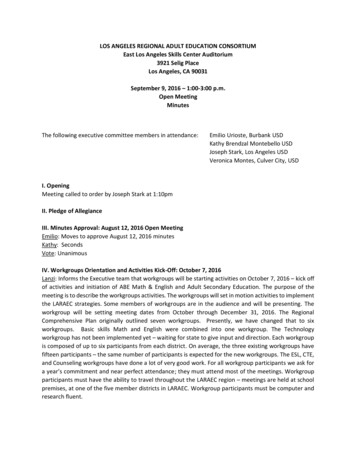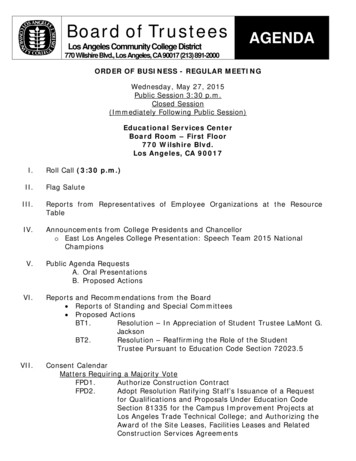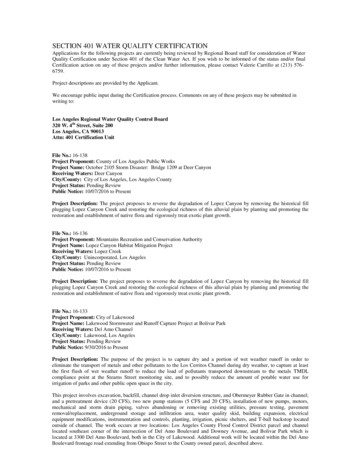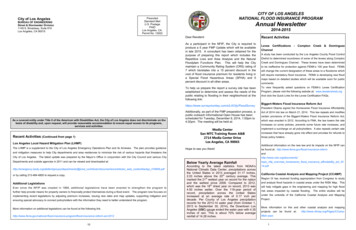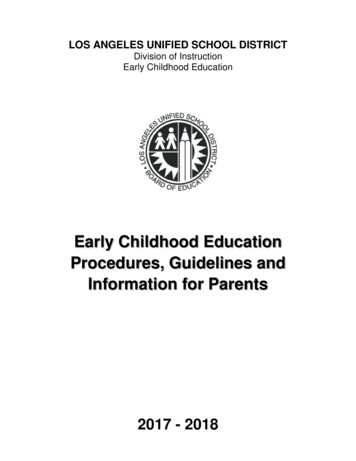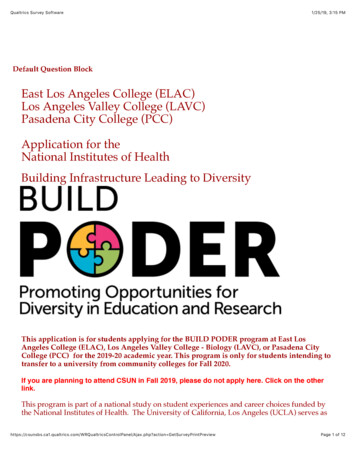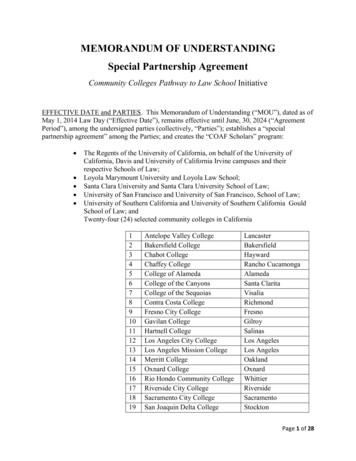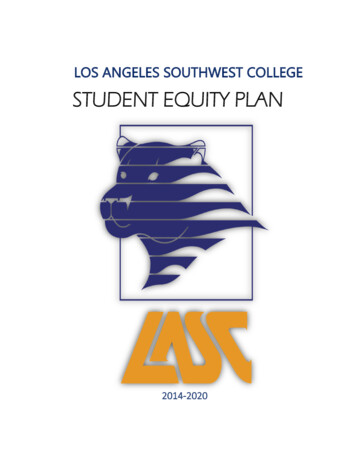
Transcription
LOS ANGELES SOUTHWEST COLLEGESTUDENT EQUITY PLAN2014-2020
LOS ANGELES SOUTHWEST STUDENT EQUITY PLANTable of ContentsSignature PageExecutive SummaryTarget GroupsGoalsActivitiesStudent Equity Funding and Other ResourcesContact Person/Student Equity CoordinatorPlanning Committee and CollaborationAccessCampus-Based ResearchOverviewIndicator Definitions and DataConclusions: Impacted Student GroupsGoals, Activities, Funding and EvaluationAccess Baseline Data and GoalsActivities to Improve Access for Target Student GroupsExpected Outcomes for Target Student GroupsCourse CompletionCampus-Based ResearchOverviewIndicator Definitions and DataConclusions: Impacted Student GroupsGoals, Activities, Funding and EvaluationCourse Completion Baseline Data and GoalsActivities to Improve Course Completion for Target Student GroupsExpected Outcomes for Target Student GroupsESL and Basic Skills CompletionCampus-Based ResearchOverviewIndicator Definitions and DataConclusions: Impacted Student Groups2
Goals, Activities, Funding and EvaluationESL and Basic Skills Completion Baseline Data and GoalsActivities to Improve ESL and Basic Skills Completion for Target Student GroupsExpected Outcomes for Target Student GroupsDegree and Certificate CompletionCampus-Based ResearchOverviewIndicator Definitions and DataConclusions: Impacted Student GroupsGoals, Activities, Funding and EvaluationDegree and Certificate Completion Baseline Data and GoalsActivities to Improve Degree and Certificate Completion for Target Student GroupsExpected Outcomes for Target Student GroupsTransferCampus-Based ResearchOverviewIndicator Definitions and DataConclusions: Impacted Student GroupsGoals, Activities, Funding and EvaluationTransfer Baseline Data and GoalsActivities to Improve Transfer for Target Student GroupsExpected Outcomes for Target Student GroupsOther College- or District-wide Initiatives Affecting Several IndicatorsGoals, Activities, Funding and EvaluationGoals Addressed by ActivitiesActivities, Funding and Evaluation to Improve Outcomes for Target Student GroupsSummary BudgetSummary Budget spreadsheetSummary Evaluation PlanAttachments3
SIGNATURE PAGE4
LOS ANGELES SOUTHWEST COLLEGE’SStudent Equity Plan Signature PageDistrict:Los Angeles Community CollegeBoard of Trustees Approval Date:12-16-15I certify that this plan was reviewed and approved by the district board of trustees on the dateshown above. I also certify that student equity categorical funding allocated to my college ordistrict will be expended in accordance the student equity expenditure guidelines published bythe California Community College Chancellor's Office (CCCCO).[College President Name]roseld@lasc.eduEmailI certify that student equity categorical funding allocated to my college will be expended inaccordance the student equity expenditure guidelines published by the CCCCO.[College Chief Business Officer Name]jacobstv@lasc.eduEmailI certify that was involved in the development of the plan and support the research goals,activities, budget and evaluation it contains.[Chief Student Services Officer Name]Doffonlc@lasc.eduEmailI certify that was involved in the development of the plan and support the research goals,activities, budget and evaluation it contains.[Chief Instructional Officer Name]brodfoll@lasc.eduEmailI certify that Academic Senate representatives were involved in the development of the plan andthe Senate supports the research goals, activities, budget and evaluation it contains.[Academic Senate President Name]callenab@lasc.eduEmail
I certify that Associated Student Body representatives were involved in the development of theplan and supports the research goals, activities, budget and evaluation it contains.montallpe@lasc.eduEmail[Student Equity 4PhoneBoard Approval Date6
EXECUTIVE SUMMARY
LOS ANGELES SOUTHWEST COLLEGE OVERVIEW:Los Angeles Southwest College (LASC) was created due to the necessity of increasing equity.Located in the heart of south Los Angeles, LASC is a beacon of hope for many of its residents. In1967, Odessa Cox, the primary founder of LASC, along with a small group of community membersbegin cultivating Cox’s vision to create an opportunity for the residents of south Los Angeles toattain higher education in their own community. Fast-forward to 47 years later and as of 2014,LASC served approximately 19,858 students. Over 69% of the student population is female while31% of students are male. Over one-half of the student population is between the ages of 19 to29, and they are primarily of African-American or Hispanic descent. The primary educational goalfor LASC students is to transfer to a four-year university. Although there has been an increase instudents choosing to pursue higher education, historically and systemically many African Americanand Hispanic students are achieving their educational goals at a much lower rate than other groupsdue to personal, financial, environmental and institutional barriers that accompany them tocampus.LASC student equity committee is dedicated to identifying and understanding the root ofunderachievement. Most importantly, it’s goal is to create and implement action items to increasethe learning and achievement of impacted student populations at LASC. Below is a briefdescription of LASC’s impacted student populations including (a) African-American, (b)Hispanic/Latino/a, (c) males, (d) foster youth, (e) veterans and disabled students.LASC’S TARGETED IMPACTED STUDENT POPULATIONS:Based upon the proportionality analysis’ 80% rule and low performance in the five studentsuccess indicators, the following populations were identified as impacted or underserved.A. African American and Hispanic/Latino Students: Los Angeles Southwest College’s currenttarget groups, as identified in the College’s Strategic Plan and disaggregated data, areAfrican American and Hispanic/Latino students. It is also important to note that LosAngeles Southwest College is a Predominantly Black Institution (PBI). African Americanstudents demonstrate low performance in each of the core equity indicators, especiallywhen compared to district and state data. The data analysis performed in thedevelopment of the student equity plan confirmed the necessity of focusing on theseethnic groups as it revealed significant achievement gaps that particularly affect AfricanAmerican and Hispanic/Latino students.B. Males: The analysis of data revealed a profound enrollment disparity between femaleand male students in both African American and Hispanic/Latino populations. Femalestudents represent 69% of the College’s credit student population, while male studentsrepresent 31%. An analysis of demographic data indicates a disparity in Hispanic/Latino8
enrollment at the college from the local service area. Hispanic/Latinos represent 56.04%of service area adult population while they only represent 35.80% of the fall 2013 creditstudent population.C. ESL/Basic Skills: LASC has a predominantly basic skills student population. Nearly all ofLASC’s students require remediation in both Math and English. In fall 2013, for example,88% of students assessed into Basic Skills English, and 92% of students assessed intoBasic Skills Math. As a result, it is important to make sure students complete basic skillssequences in a timely manner. All these groups compose the basis for allocating StudentEquity funds to address achievement gaps.D. Foster Youth: South Los Angeles has the highest number of residents who are fosteryouth and former foster youth in the state. As of Fall 2015 LASC serves 301 foster youthstudents. The student equity committee sees the importance of ensuring foster youthstudents receive access to program services and support needed to complete theireducation at Los Angeles Southwest College and beyond.E. Veterans: As with many colleges in Southern California, we are experiencing an influx ofVeterans who are seeking an education after military service. As of Fall 2015 LASC serves317 veterans. The campus is developing interventions to outreach and serve Veteranstudents to ensure their academic success and completion.F. Disabled: Disabled student experience health, learning and physical disabilities. Thecampus currently has Disabled Students Program and Services (DSP&S). Currently DSP&Sserves 66.7% African American students, 20.8% Hispanic, 62.5% females and 37% males.Majority of the disabled student population are African American and Hispanic descent.To address the impacted and underserved student populations above, a Student Equitycommittee was developed. Below describes the student equity committee planning processduring spring 2014 and the equity proposal process during Fall 2015.STUDENT EQUITY COMMITTEE PLANNING PROCESSLos Angeles Southwest College (LASC) embarked on a detailed self-study of equity gaps in studentsuccess among different population groups on campus in the spring 2014. The Student EquityPlanning Committee, a subcommittee of the Student Success Committee (Academic SenateCommittee) examined student equity success data by using the tools recommended in the“Updated Student Equity Plan” document as well as local college tools. Data was discussed duringthe Equity Planning Retreat in June 2014. After the retreat, the committee was divided intosmaller “core planning groups” to focus on one of the core indicators prescribed by Student Equitycore planning group.9
2014-2015 Student Equity Core Planning Group:The core planning groups were comprised of one administrator and one faculty member/classifiedstaff who served as leads within the group. The core planning groups were also composed of otherfaculty, staff, administrators, and students who had experience or skill within the designatedsuccess indicator. Each group met throughout the summer to provide its recommendation forgoals, interventions, and evaluation methodology for each success indicators. All the groups metagain in August 2014 to compile all the recommendations and discuss common themes within theplan.2015-2016 Equity Proposal Process:In addition to the student equity committee core planning group work during spring 2014, duringfall 2015 student equity proposals were provided to the LASC campus community. This procedureencouraged the college community to identify equity gaps within their respective areas andpropose programs and initiatives that close equity gaps. This ensured that all LASC areas wereincluded in the creation of the action steps towards equitable outcomes. A total of 31 equityproposals were submitted spanning instructional faculty, classified, administration and supportservices.STUDENT EQUITY CORE AREAS:Based on the core planning analysis and student equity proposals, the student equity committeedeveloped goals and activities to address LASC’s equity gaps. Thus, the committee decided onthree core areas (a) access expansion (b) basic skill development and academic intervention (c)and professional development.A. Access Expansion: The student equity committee believed it was critical to expand uponaccess with emphasis upon outreach and recruitment, marketing, cross campuscommunication expansion, and first year integration. Furthermore, developing strongpartnerships with local high schools and community organizations are critical to increasingaccess for the identified impacted students at LASC.B. Basic Skill Development and Academic Intervention: LASC student populations primarilyenter LASC at the basic skill level. Based upon this reality the committee will concentrateon academic intervention practices, quality support and services, and increasingacademic resources for the impacted and underserved groups. Increasing tutoring andsupplemental instruction will increase the number of students who successfully completebasic skill English, mathematics and gateway courses.C. Professional Development Series: Faculty, Staff and Student Tracks: The professionaldevelopment series will Increase faculty, staff and students knowledge pertaining toincreasing the five student success indicators. Furthermore, the professionaldevelopment series will provide faculty and staff with additional resources andapproaches to student engagement, pedagogy, and support to decrease equity gaps.10
STUDENT EQUITY GOALS AND ACTIVITIES:The student success goals, activities and progress towards an equity-centered institution aredescribed below. The student success goals addressed includes (a) access, (b) course completion(c) ESL/Basic Skills (d) transfer (e) and degree and certificate completion.Goal A. Access: Increase enrollment by 2% through outreach and recruitment, targeted marketing,cross-campus communication and first year transition activities by 2018.Access Impacted Groups: Hispanic/Latino, Veterans, Foster Youth, and male studentsAccess Activities:A.1 Outreach and Recruitment: Outreach and Recruitment staff hired 6 outreach staff membersand conducted recruitment at local feeder schools, community organizations and college fairsduring the 2014-2015 academic year. The Outreach and Recruitment Coordinator worked incoordination with participating feeder K-12 schools to conduct outreach visits and meetindividually and in small groups with all graduating seniors, specifically those in the impactedsubgroups (Hispanic/Latino, males, foster youth), in order to provide guidance and assistancewith the application and matriculation process at the college.A.2 Targeted Marketing Material Expansion: Targeted marketing materials were developedduring 2015 including a veteran’s brochure and an interest card for prospective students that arecurrently under review. The marketing materials will be disseminated starting winter 2016 at alltargeted outreach events for the impacted groups. The public information officer will hire anassistant to focus upon educational marketing materials for the impacted groups starting winter2016.A.3 LASC’s High School Partnership: LASC’s High School Partnership serves as a pathway for localfeeder high school graduates and dual enrollment students to receive comprehensiveorientation and support early. In collaboration with local feeder high school and middle schooladministration the pathway will consist of guidance and support through the student successand support program services which includes applying, orientation, assessment, counseling andfollow-up services. Furthermore, the high school partnership will strengthen relationships withlocal feeder high schools and middle schools to create action steps to improve LASC’s enrollmentof the impacted groups.A.4 First Year Summer Bridge Program: FYE Summer Bridge will offer extended orientation,English and Math skill building, and one-on-one counseling to assist students as they navigateand prepare for their first year of college. Students will be monitored to determine students’academic progress and intrusive/preventive counseling during their first year at LASC.11
Goal B. Course Completion: Increase course completion by 2% through supplemental instructionand tutoring expansion, academic intervention and supplies, and mentorship by 2017.Impacted Groups: African American, Latino, Males, and Foster Youth studentsCourse Completion Activities:B.1 Supplemental Instruction/ SMART Thinking Online Tutoring: Supplemental Instruction (SI) isan academic assistance program that utilizes peer-assisted study sessions. SI sessions areregularly-scheduled, informal review sessions in which students compare notes, discussreadings, develop organizational tools, and predict test items. Students learn how to integratecourse content and study skills while working together. SI is a student centered approach tolearning as the program targets high-risk courses rather than high-risk students.During fall 2014- summer 2015 the following courses had supplemental instruction; accounting,biology, English, health, math, psychology, reading, sociology and Spanish. These courses werechosen due to high enrollment and low completion rates. A total of twenty supplementalinstructors were hired during the 2014-2015 academic years. SMART Thinking, an online tutoringprogram was offered in the Student Success Center. A total of 405 students used SMART thinkingduring the 2014-2015 academic year.B.2 Reinstitute College Reading Assessment and Reading ApprenticeshipBy reinstituting the college reading assessment, counselors will be able to more accuratelyrecommend and place students in reading courses that are appropriate for students’ needs.Reading Apprenticeship will provide faculty with added training and support to ensure thatstudents have increased access to course material.B.3 LASC Mentor Program: The Student Success Center piloted a Mentor Program for first timestudents, particularly African-American, Hispanic/Latino, foster youth, and Veterans, during Fall2014 with 30 students. Students were paired with college faculty, staff, or administrator mentorswho met assigned students at least three times each semester. The meetings with the studentsconsisted of the following: initial meeting for icebreakers, academic activity, and cultural activityon campus. The mentor program will be re-established starting spring 2016.B.4 Book and Calculator Loaning Program: As stated in the data collected in fall 2013 the servicearea of LASC has the highest poverty rates, many of the identified impacted groups cannot affordto purchase books or calculators for courses. Students also experience delay in receivingfinancial aid which delays purchasing books. In an effort to provide students with additionalacademic resources, the campus will premiere a book and calculator loaning program housed inthe Student Success Center located in the library in fall 2016.12
B.5 Bus Voucher Program: The bus voucher program is a critical resource for LASC's impactedstudents. The campus-based research on access indicates that LA southwest location has thehighest poverty and unemployment rates in the nation. Furthermore, the service area is in thelower median household income and the lowest level of adult education attainment in California.Identifying financial resources to encourage and support students obtaining their educationalgoals is important. Based upon these findings the bus voucher program will provide theimpacted groups with access to LA Southwest College to complete their courses.Goal C. ESL/Basic Skills: Increase ESL and Basic Skills completion by 2% through supplementalinstruction and tutoring, professional development and first year academic intervention by 2018.ESL/Basic Skills Impacted Groups: African American, Latino, Males, Veterans and Foster YouthstudentsESL/Basic Skills Activities:C.1 Reinstitute LASC’s Faculty/Staff Academy with a Student Equity Professional DevelopmentSub Committee: The faculty academy was a pilot program starting in the fall of 2012 as part ofour Achieving the Dream initiative with a small cohort of new and veteran instructors. As a subcommittee of faculty/staff academy the Student Equity Coordinator, Vice President of StudentServices, and the Chair of the Professional Development Committee will develop and implementprofessional development training for faculty and staff members to be more culturallyresponsive to the challenges that impacted groups face inside and outside of the classroom.During summer 2015 the student equity professional development series started with Dr. J LukeWood who presented on Men of Color Student Success during flex day. During fall 2015 threeworkshops were implemented including student equity training, culturally relevant practices andquality customer service. All of these initiatives supported educating and informing the greaterLASC community about impact and becoming an equity-centered institution.C.2 Summer Jam: Math and English Assessment Preparation Program:During summer 2015 the campus piloted its first Summer Jam English and Math AssessmentPreparation Program. A total of 30 students completed a week long English and mathpreparation with LASC instructors, received educational planning, college success strategies andresources, and guaranteed placement into an English and math class during fall 2015. Currentlythe campus is awaiting grades to determine student’s success. Furthermore, students completeda survey in which over 95% of the students shared that Summer Jam was helpful, supportive anda critical resource for all first-year students. The pilot program provided the campus with theopportunity to understand the strengths and areas of improvement for future summer jamprograms.C.3 Supplemental Instruction/ SMART Thinking Online Tutoring: Supplemental Instruction (SI) isan academic assistance program that utilizes peer-assisted study sessions. SI sessions areregularly-scheduled, informal review sessions in which students compare notes, discuss13
readings, develop organizational tools, and predict test items. Students learn how to integratecourse content and study skills while working together. SI is a student centered approach tolearning as the program targets high-risk courses rather than high-risk students.During fall 2014- summer 2015 the following courses had supplemental instruction; accounting,biology, English, health, math, psychology, reading, sociology and Spanish. These courses werechosen due to high enrollment and low completion rates. A total of twenty supplementalinstructors were hired during the 2014-2015 academic years. SMART Thinking, an online tutoringprogram was offered in the Student Success Center. A total of 405 students used SMART thinkingduring the 2014-2015 academic year.Goal D. Degree and Certificate Completion: Increase degree and certificate completion by 3%through educational marketing materials, campus wide degree completion initiatives, andcounseling expansion by 2020.Degree and Certificate Completion Impacted Groups: African American, Latino, Males, Veteransand Foster Youth studentsDegree and Certificate Completion Activities:D.1 Multi-Cultural Student Success Center (African and Latino Male Students): Development of amulti-cultural center will be established in fall 2016 to increase transfer readiness and degreecompletion for men of color. The multicultural center will primarily serve African-American andHispanic male students which are LASC’s dominant student populations. Based on these findingsthe campus will provide a comprehensive program that holistically develops male students. Themulti-cultural center will provide a centralized location in which African-American and Hispanicmales can obtain key academic, social and career developmentD.2 Student Equity Staffing: To ensure that all student equity initiatives are completedeffectively, the following positions will be filled starting fall 2015. The student equity staff willconsist of an equity coordinator, research analyst, administrative assistant and programassistants.D.3 Intrusive Counseling for Targeted Student Populations: To ensure the targeted populationsreceive the appropriate information, support and accommodations pertaining to transfer anddegree completion, three counselors will be hired starting fall 2015. Student equity counselorswill be responsible for (a) contacting students with over 30 units to verify they have completed acomprehensive educational plan and are on track to meeting graduation completionrequirements (b) complete two transfer workshops per semester (c) complete two degreecompletion workshops per semester (d) and provide academic intervention meetings withstudents falling under a 2.0 grade point average per semester.14
Goal E. Transfer: Increase transfer rates by 3% through transfer research analysis, professional andstudent development, campus wide transfer preparation initiatives, and transfer counselingexpansion by 2020.Impacted Groups: African American, Latino, Males, Females, Veterans and Foster Youth studentsTransfer Activities:E.1 Transfer Analysis Data Project: After reviewing the data, a more comprehensive plan will bedeveloped by the end of the 2015-16 academic year to address the specific needs of AfricanAmerican and Hispanic students with regard to transfer. The plan will be implemented beginningin the 2016-17 academic year. Beginning in the 2017-18 academic years, progress on the planwill begin to be evaluated by analyzing disaggregated transfer data by categories of students.E.2 HBCU & HSI Fairs and Collaboration: Historically Black College and Hispanic Serving InstitutionsTransfer Fairs will be implemented in the spring of 2016. This event can be combined with thecollege’s annual career fair. Currently, the College provides a transfer/career fair each semester.However, the college has not focused on attracting Historically Black College and Hispanic ServingInstitutions to its transfer fair. This will allow for students to learn about academic opportunitiesbeyond the UC and CSUsE.3 Intrusive Counseling for Targeted Student Populations: To ensure the targeted populationsreceive the appropriate information, support and accommodations pertaining to transfer anddegree completion, three counselors will be hired starting fall 2015. Student equity counselors willbe responsible for (a) contacting students with over 30 units to verify they have completed acomprehensive educational plan and are on track to meeting graduation completion requirements(b) complete two transfer workshops per semester (c) complete two degree completionworkshops per semester (d) and provide academic intervention meetings with students fallingunder a 2.0 grade point average per semester.E.4 Puente Program Expansion: The Puente Program is a national award winning transferreadiness program co-sponsored by the University of California and the California CommunityCollege Chancellor's Office. The Mission of the Puente Program is to increase the number ofeducationally underserved students who enroll in four-year colleges and universities, earndegrees, and return to the community as leaders and mentors to succeeding generations.Student equity will assist with additional counseling hours and cultural, educational and transferready programming.E.5 DSPS Woodcock Johnson’s Cognitive Assessment:DSPS contributes to the College environment by providing accommodations, auxiliary aids,counseling and guidance for students with disabilities. Its goal is to maximize students withdisabilities independence, decision making, and awareness of their strengths and limitations sothat they can self-advocate. The Woodcock Johnson’s Cognitive Assessment will assist DSPS staffin identifying learning disabilities and tailored accommodations for each student.15
Student Equity Funding Sources and ResourcesThe student equity committee developed a budget that primarily focused upon the highestequity gaps. One of the major equity gaps is ESL/Basic Skill completion, according to the Fall2013 data collected 88% of LASC students were placed in basic skill English and 92% were placedin basic skill math. A large amount of funding resources was allocated towards supplementalinstruction which serves as an academic intervention for ESL/ basic skill students.A significant amount of funding resources was also dedicated to outreach and recruitment. Thecentral service area of LASC has the highest poverty and unemployment rates in the nation.Therefore the campus is committed to enhancing outreach and marketing, in hopes of increasingaccess and developing more community based partnerships. Furthermore, funding was allocatedtowards professional development for instructional faculty, faculty, classified, and supportservices pertaining to how to better instruct, serve and accommodate impacted students.The student equity committee is dedicated to continuing to integrate need base resourceallocations. This will be completed through ongoing collection of student data and analysis toidentify equity gaps and implement action steps.Please refer to the attached budget summary for a detailed overview of funding allocations.Contact Person/Student Equity CoordinatorLASC’s Equity Coordinator oversees and manages all equity initiatives. The Student EquityCoordinator Ms. Tyffany Dowd can be contacted at 323-241-5354 or via email at dowdt@lasc.edu.16
Planning Committee and Collaboration17
STUDENT EQUITY COMMITTEE PLANNING PROCESSLos Angeles Southwest College (LASC) embarked on a detailed self-study of equity gaps instudent success among different population groups on campus in the spring 2014. The StudentEquity Planning Committee, a subcommittee of the Student Success Committee (AcademicSenate Committee) examined student equity success data by using the tools recommended inthe “Updated Student Equity Plan” document as well as local college tools. Data was discussedduring the Equity Planning Retreat in June 2014. After the retreat, the committee was dividedinto smaller “core planning groups” to focus on one of the core indicators prescribed by StudentEquity core planning group.2014-2015 Student Equity Core Planning Group:The core planning groups were comprised of one administrator and one facultymember/classified staff who served as leads within the group. The core planning groups werealso composed of other faculty, staff, administrators, and students who had experience or skillwithin the designated success indicator. Each group met throughout the summer to provide itsrecommendation for goals, interventions, and evaluation methodology for each successindicators. All the groups met again in August 2014 to compile all the recommendations anddiscuss common themes within the plan. Subsequently, the Student Equity Report waspresented during shared governance committee meetings and campus forums to seek input andcreate discussions on equity data. These meetings consisted of the following: Strategic PlanningRetreat, Academic Senate, Fall Flex Day, and College Council. Inputs from these meetings wereincluded in the equity planning recommend
LOS ANGELES SOUTHWEST COLLEGE OVERVIEW: Los Angeles Southwest College (LASC) was created due to the necessity of increasing equity. Located in the heart of south Los Angeles, LASC is a beacon of hope for many of its residents. In 1967, Odessa Cox, the primary founder of LASC, along with a small group of community members
